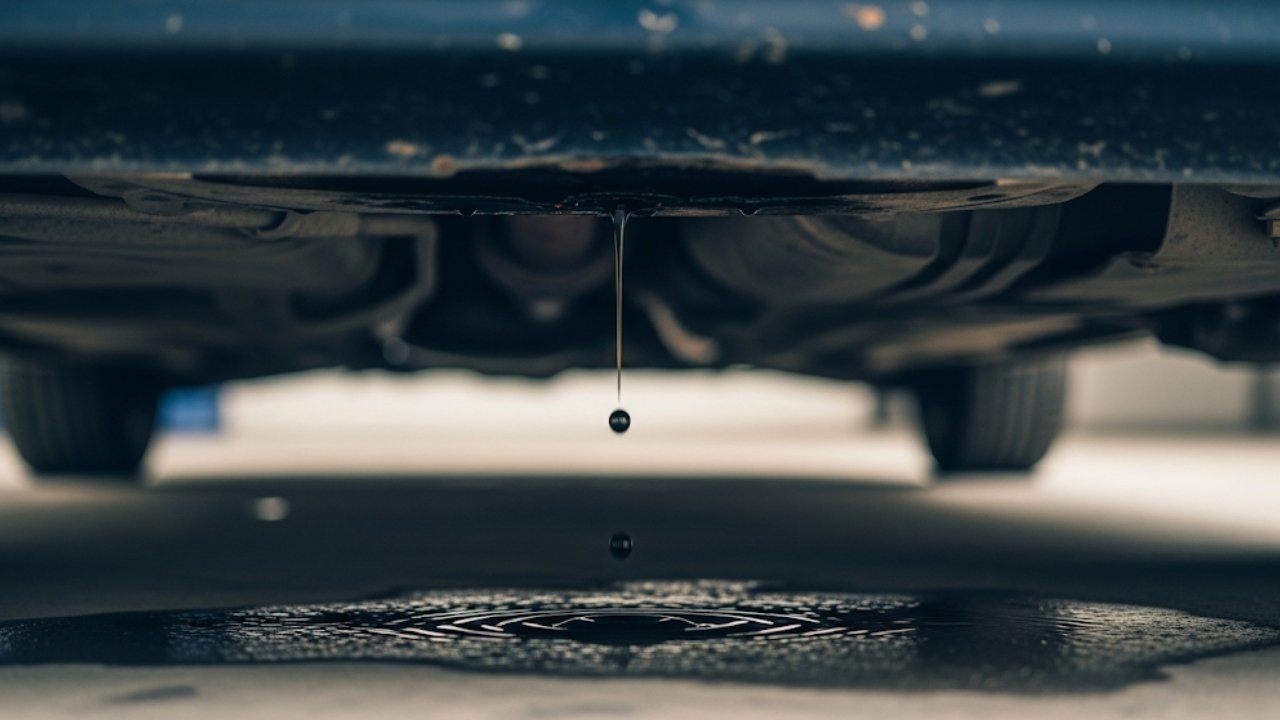Oil Is Leaking from My Car at a Steady Rate of 1 Drop Every 0.4 Seconds

Imagine you’re driving down a quiet street. Everything seems normal—until you park and notice a dark trail of oil drops tracing your path like breadcrumbs left by a mechanical Hansel. You look beneath your car, and there it is: a slow, steady oil leak dripping every 0.4 seconds. Now your brain starts racing. You’re moving at a constant velocity, and you wonder—what kind of pattern is this leak creating on the pavement behind you?
It may sound like a physics riddle wrapped in an automotive nightmare, but it’s a real concern. Understanding the pattern of the oil leak isn’t just for fun—it can actually help you diagnose the problem, gauge how bad it is, and even figure out how long you’ve been leaking without realizing it.
Let’s break this down. In this article, we’ll dive into:
The relationship between leak rate and movement.
What pattern this creates on the ground.
How it can reveal the extent of the damage.
Why your velocity and leak interval matter.
Some real-life tips and personal stories to drive it home.
By the end, you’ll not only know the answer to “what pattern would best represent the leak on the pavement if I was moving with a constant velocity?”—you’ll understand why that answer actually matters.
When Cars Cry: Understanding the Leak Itself

It’s kind of like a ticking clock. One Mississippi, two Missi—drip.
That rhythm, though small, means your car is bleeding. Think of engine oil like the lifeblood of your vehicle. It keeps everything smooth, lubricated, and cool. A steady leak means you’re losing that lifeblood bit by bit.
And even one drop every 0.4 seconds adds up. Over a minute, that’s 150 drops. Multiply that by how far you’re driving, and soon your engine’s running dry—and that’s when things get ugly.
This isn’t just about mechanics—it’s about your safety, your wallet, and even your environment. Oil can damage roads, kill grass, and harm animals. And if the leak reaches your tires or brakes? That’s a danger zone.
So we know the leak is bad. But what does it actually look like on the road behind you?
The Dance of Drops: A Pattern in Motion
So here’s the million-dollar question: If oil is leaking from my car at a steady rate of 1 drop every 0.4 seconds, and I’m moving at a constant velocity, what does the pattern on the pavement look like?
Short answer? A series of evenly spaced dots.
But let’s bring this to life. Imagine a leaky pen dragging across a piece of paper at a constant speed, letting a drop fall every half second. You’d see a trail of ink spots, each one spaced the same distance apart. That’s exactly what your car is doing—except it’s oil, not ink.
In scientific terms, this pattern is linear and uniform. Why?
The drop interval (0.4 seconds) is consistent.
The velocity is constant (no speeding or slowing).
Therefore, each drop hits the pavement at regular distance intervals.
Here’s a simple way to visualize it:
| Time (Seconds) | Drop Number | Distance Covered (Assuming 30 mph) |
|---|---|---|
| 0.0 | 1 | 0 ft |
| 0.4 | 2 | 17.6 ft |
| 0.8 | 3 | 35.2 ft |
| 1.2 | 4 | 52.8 ft |
| 1.6 | 5 | 70.4 ft |
(Note: 30 mph = 44 feet per second)
So every 0.4 seconds, a drop falls about 17.6 feet apart. That creates a dotted line behind you—like a Morse code message left on the pavement.
The Real-World Math of the Drip Trail
Let’s make this personal.
When I was younger, I drove a beat-up Toyota Corolla. One day after work, I noticed a trail of dots leading from the parking lot to the gas station. Turns out it was me. My car had a rear main seal leak, and it was dripping like clockwork.
Here’s what I learned.
To figure out the exact pattern, all I needed was:
Speed of my car (let’s say 30 mph)
Time between drops (0.4 seconds)
Using this formula:
Distance between drops = Velocity × Time
In my case:
Distance = 44 ft/s × 0.4 s = 17.6 feet
That’s the spacing between each oil drop on the pavement. Uniform. Predictable. Like footsteps.
And yes, I followed the trail back to my driveway and confirmed it with a flashlight. It was weirdly satisfying, like solving a mystery only I knew existed.
Velocity Matters More Than You Think
Now, what if you were driving faster—or slower?
Let’s look at some examples:
| Speed (mph) | Feet/Second | Distance Between Drops (0.4s) |
|---|---|---|
| 10 mph | 14.7 ft/s | 5.9 ft |
| 20 mph | 29.3 ft/s | 11.7 ft |
| 40 mph | 58.7 ft/s | 23.5 ft |
| 60 mph | 88 ft/s | 35.2 ft |
Faster speed = more distance between each drop. That means:
If you’re going fast, the drops are far apart—a stretched-out trail.
If you’re going slow, the drops are closer—a tighter cluster.
That’s why oil patterns on highways look different than in a parking lot. It’s all about how fast you’re moving when the leak happens.
Why This Pattern Actually Matters
Okay, so your car is leaking and creating a pattern of evenly spaced drops. Why should you care?
Here’s why:
It helps mechanics trace the problem. The length and spacing show how long and how far you’ve been leaking.
You can estimate how much oil you’ve lost.
You’ll understand if it happened while driving or parked.
It lets you figure out how fast the leak is getting worse.
Mechanics can sometimes follow the drip trail right into your garage and point to the culprit like a detective at a crime scene.
And if the leak happens at random intervals, it’s a different issue—maybe a pressure-based leak or a loose filter. But a steady leak like this is usually from a failing gasket, seal, or hose.
The Environmental Impact of Your Oil Trail
Let’s step back a bit. We’ve talked about the physics, but what about the environmental damage?
Oil leaking from my car at a steady rate of 1 drop every 0.4 seconds isn’t just a quirky roadside pattern. It’s pollution.
Oil seeps into:
Soil, killing plants.
Waterways, harming fish and wildlife.
Pavement, creating slick spots for accidents.
Over time, even a small leak adds up. One drop seems tiny, but over an hour of driving?
3600 seconds ÷ 0.4 = 9,000 drops
That’s roughly 3–4 quarts of oil, depending on drop size. That’s practically your entire oil system!
If that goes into the ground? You’ve created a miniature ecological disaster.
What Causes a Steady Oil Leak?
So what’s behind a consistent oil drip like this?
Here are common causes:
Worn engine gaskets
Cracked oil pan
Damaged valve cover
Loose oil filter or drain plug
Degraded seals
Each of these can cause a rhythmic, steady drip when the engine is on or under pressure. And if it’s leaking even while parked, it’s probably gravity-driven from the pan or gasket.
How to Spot and Measure the Oil Leak Trail
If oil is leaking from my car at a steady rate of 1 drop every 0.4 seconds, how do I know for sure? The answer is part observation, part detective work, and part math.
Start with the basics:
Look under your car in the morning. Do you see oil spots?
Check the driveway or garage for a trail or random puddles.
Use chalk or masking tape to mark drops over time.
Next, take it for a short drive. Park. Walk the path back with a flashlight (especially at dusk—it’s easier to spot wet stains in angled light). If the drops form a straight, evenly spaced trail, then yes, it confirms a consistent leak pattern during motion.
To estimate the leak rate:
Place a clean tray or cardboard under the car when parked.
Count the number of drops per minute.
Compare it to the distance you traveled during that time.
Let’s say you drove 10 minutes at 30 mph:
That’s 5 miles = 26,400 feet.
10 minutes × 60 seconds = 600 seconds.
600 seconds ÷ 0.4 = 1,500 drops.
26,400 feet ÷ 1,500 drops = 17.6 feet between drops, as expected.
It’s basic physics in motion—your car is unintentionally painting a canvas with oil.
How to Prevent or Slow an Oil Leak
Now that we’ve cracked the code of the trail, let’s talk prevention. Because trust me—no one wants to be “that driver” leaving a trail of sludge behind.
Practical tips to stop or slow oil leaks:
Regularly check oil levels.
Catch drops before they become drips.Use UV dye leak detection kits.
Mechanics use them, but you can too. Add the dye, drive, and shine a UV light to spot the origin.Change old gaskets and seals.
Over time, rubber hardens, cracks, and fails.Avoid cheap oil filters.
Poor-quality filters are a common source of leaks. Stick with OEM or trusted brands.Don’t overfill oil.
Too much pressure inside the system can cause blowouts in seals and gaskets.Get regular inspections.
A quick 10-minute look can save you hundreds.
I once ignored a slow leak for two months thinking, “It’s just a couple drops.” That mindset cost me a full engine rebuild. Now I carry a white mat in my trunk to check parking spots, especially after long drives.
Metaphor Time: The Leaking Fountain Pen
To put it in perspective, think of your engine like a fountain pen. It’s full of black ink (your oil), and it glides across a page (the road). But if there’s a tiny crack in the reservoir or nib, you start seeing spots every few inches.
Those spots aren’t just messes—they’re clues. They tell you:
Where the problem started.
How often it’s happening.
How much damage is likely being done.
Your car is talking, even if you’re not listening.
Bullet Recap: Why Your Oil Leak Pattern Matters
Let’s sum up the essential takeaways in one glance:
A leak every 0.4 seconds while driving = uniformly spaced trail.
The faster you drive, the further apart the drops.
The pattern looks like dots in a straight line, not a smear or puddle.
It helps diagnose leak severity and duration.
Environmental impact is real—even one drop can spread.
Speed × time = distance between drops. Simple, but powerful.
This isn’t just about physics. It’s about knowing your car. And being the kind of driver who doesn’t ignore the signs—literally written on the road.
FAQs About Oil Leak Patterns While Driving
Q1: How long can I drive with a leak that drips every 0.4 seconds?
A: Not long. At that rate, you could lose a quart in under an hour depending on drop size. That puts your engine at serious risk of overheating or seizing.
Q2: What if the oil drops don’t form a straight line?
A: Then your leak might be inconsistent or happening while turning, braking, or accelerating. It could also mean your suspension is bouncing or your vehicle is not aligned.
Q3: Can rain wash away the oil trail?
A: Rain can dilute or spread the oil, but not completely erase it. You’ll often see rainbow streaks where oil mixed with water. Still damaging, still traceable.
Q4: Is there a way to track the trail using GPS or tech?
A: Not directly, but you can use dashcam footage or GPS history to estimate where your car was during the leak and backtrack to find signs.
Q5: Does this mean I need to stop driving immediately?
A: If you’re losing a drop every 0.4 seconds while moving, yes. At minimum, check your oil immediately and add oil if low. Then head straight to a mechanic.
Q6: What kind of damage can this leak cause?
A: Aside from engine failure, it can cause environmental contamination, slippery roads, stained driveways, and loss of power if it spreads to belts or the transmission.
Q7: Will a stop-leak additive work?
A: In some cases, yes—for small seal leaks. But it’s a temporary fix at best. Never rely on additives alone for critical repairs.
Q8: Can I use kitty litter or sand to clean up oil trails?
A: Yes! Kitty litter absorbs oil really well. Just sprinkle it, let it sit, and sweep it up. But remember: cleanup is great—but fixing the leak is better.
Final Thoughts: Follow the Trail Back to Health
When oil is leaking from my car at a steady rate of 1 drop every 0.4 seconds, it’s not just a mechanical issue—it’s a cry for help. A trail of tears your car leaves behind, hoping you’ll notice.
I’ve made that mistake before. Ignored it. Thought I could stretch one more week. I ended up stranded in the rain, calling a tow truck at midnight.
That trail? It’s a story your car is telling. Don’t ignore it.
Listen. Watch. Count. React.





